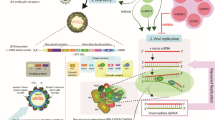Abstract
The canine parvovirus type 2 (CPV-2) causes an acute disease in dogs. It has been found to induce cell cycle arrest and DNA damage leading to cellular lysis. In this paper, we evaluated the apoptotic potential of the “new CPV-2a” in MDCK cells and elucidated the mechanism of the induction of apoptosis. The exposure of MDCK cells to the virus was found to trigger apoptotic response. Apoptosis was confirmed by phosphatidylserine translocation, DNA fragmentation assays, and cell cycle analysis. Activation of caspases-3, -8, -9, and -12 and decrease in mitochondrial potential in CPV-2a-infected MDCK cells suggested that the CPV-2a-induced apoptosis is caspase dependent involving extrinsic, intrinsic, and endoplasmic reticulum pathways. Increase in p53 and Bax/Bcl2 ratio was also observed in CPV-2a-infected cells.




Similar content being viewed by others
References
Giorgi, C., Wieckowski, M. R., Pandolfi, P. P., & Pinton, P. (2011). Communicative & Integrative Biology, 4, 334–335.
Kerr, J. F., Wyllie, A. H., & Currie, A. R. (1972). British Journal of Cancer, 26, 239–257.
Everett, H., & McFadden, G. (1999). Trends in Microbiology, 7, 160–165.
Everts, B., & van der Poel, H. G. (2005). Cancer Gene Therapy, 12, 141–161.
Ravindra, P. V., Tiwari, A. K., Ratta, B., Bais, M. V., Chaturvedi, U., Palia, S. K., et al. (2009). Virus Research, 144, 350–354.
Chen, A. Y., & Qiu, J. (2010). Future Virology, 5, 731–743.
Singh, P. K., Doley, J., Kumar, G. R., Sahoo, A. P., & Tiwari, A. K. (2012). Indian Journal of Medical Research, 136, 571–584.
Decaro, N., & Buonavoglia, C. (2012). Veterinary Microbiology, 155, 1–12.
Blau, H. M., Chiu, C. P., & Webster, C. (1983). Cell, 32, 1171–1180.
Bauder, B., Suchy, A., Gabler, C., & Weissenbock, H. (2000). Journal of Veterinary Medicine B, Infectious Diseases and Veterinary Public Health, 47, 775–784.
Morita, E., Nakashima, A., Asao, H., Sato, H., & Sugamura, K. (2003). Journal of Virology, 77, 2915–2921.
Ozawa, K., Ayub, J., Kajigaya, S., Shimada, T., & Young, N. (1988). Journal of Virology, 62, 2884–2889.
Mincberg, M., Gopas, J., & Tal, J. (2011). Virology, 412, 233–243.
Angelova, A. L., Aprahamian, M., Grekova, S. P., Hajri, A., Leuchs, B., Giese, N. A., et al. (2009). Clinical Cancer Research, 15, 511–519.
Chen, Y. Q., de Foresta, F., Hertoghs, J., Avalosse, B. L., Cornelis, J. J., & Rommelaere, J. (1986). Cancer Research, 46, 3574–3579.
Ravindra, P. V., Tiwari, A. K., Ratta, B., Chaturvedi, U., Palia, S. K., & Chauhan, R. S. (2009). Virus Research, 141, 13–20.
Truyen, U. (2006). Veterinary Microbiology, 117, 9–13.
Mohan Raj, J., Mukhopadhyay, H. K., Thanislass, J., Antony, P. X., & Pillai, R. M. (2010). Infection Genetics and Evolution, 10, 1237–1241.
Nykky, J., Tuusa, J. E., Kirjavainen, S., Vuento, M., & Gilbert, L. (2010). International Journal of Nanomedicine, 5, 417–428.
Schwartzman, R. A., & Cidlowski, J. A. (1993). Endocrine Reviews, 14, 133–151.
Saxena, L., Kumar, G. R., Saxena, S., Chaturvedi, U., Sahoo, A. P., Singh, L. V., et al. (2013). Virus Research, 173, 426–430.
Schmittgen, T. D., & Livak, K. J. (2008). Nature Protocols, 3, 1101–1108.
Kumar, R., Tiwari, A. K., Chaturvedi, U., Kumar, G. R., Sahoo, A. P., Rajmani, R. S., et al. (2012). Applied Biochemistry and Biotechnology, 167, 2005–2022.
Ellis, R. E., Jacobson, D. M., & Horvitz, H. R. (1991). Genetics, 129, 79–94.
Nicoletti, I., Migliorati, G., Pagliacci, M. C., Grignani, F., & Riccardi, C. (1991). Journal of Immunological Methods, 139, 271–279.
Ohshima, T., Iwama, M., Ueno, Y., Sugiyama, F., Nakajima, T., Fukamizu, A., et al. (1998). Journal of General Virology, 79(Pt 12), 3067–3071.
Rayet, B., Lopez-Guerrero, J. A., Rommelaere, J., & Dinsart, C. (1998). Journal of Virology, 72, 8893–8903.
Yu, J., Zhang, L., Hwang, P. M., Kinzler, K. W., & Vogelstein, B. (2001). Molecular Cell, 7, 673–682.
Hay, S., & Kannourakis, G. (2002). Journal of General Virology, 83, 1547–1564.
Strasser, A., O′Connor, L., & Dixit, V. M. (2000). Annual Review of Biochemistry, 69, 217–245.
Zhang, H., Gogada, R., Yadav, N., Lella, R. K., Badeaux, M., Ayres, M., et al. (2011). PLoS One, 6, e16379.
Mousset, S., & Rommelaere, J. (1982). Nature, 300, 537–539.
Attardi, L. D., Lowe, S. W., Brugarolas, J., & Jacks, T. (1996). The EMBO Journal, 15, 3693–3701.
Acknowledgments
The authors wish to thank the Director of Indian Veterinary Research Institute, Izatnagar for providing facilities. This work was carried out by a funding from NAIP under project code C4/C3001.
Author information
Authors and Affiliations
Corresponding author
Rights and permissions
About this article
Cite this article
Doley, J., Singh, L.V., Kumar, G.R. et al. Canine Parvovirus Type 2a (CPV-2a)-Induced Apoptosis in MDCK Involves Both Extrinsic and Intrinsic Pathways. Appl Biochem Biotechnol 172, 497–508 (2014). https://doi.org/10.1007/s12010-013-0538-y
Received:
Accepted:
Published:
Issue Date:
DOI: https://doi.org/10.1007/s12010-013-0538-y




